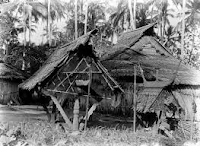Tobelo's Animism
Based on data obtained from the 2010 BPS census, there are 1340 ethnic groups in the country. The Wana tribe comes from Kalimantan and is located in the interior of the eastern part of Central Sulawesi province.
The Wana tribe usually calls themselves Tau Taa, different from the term used by outsiders, namely Tau Taa Wana, which means people who live in forest areas. This tribe is often referred to as the Togutil tribe and is a more closed group than the coastal Tobelo tribe. In the local language, the word togutil " is o hanga manyawa, which means backward, rural, and left behind.
The term Kubu itself comes from the word ngubu / ngubun which in Malay means hiding in the forest. They occupy a forest area about 150 km from the Arafura Sea. There is a Tobelo tribe that lives in the Aketajawe Lolobata National Park area.
Some reach the Raja Ampat Islands, Papua. Irfan Ahmad, a lecturer in history at Khairun Ternate University, said that based on Leirissa's records, since the Tobelo people allied with the Ternate Sultanate & recognized the Dutch colonial government in the 17th century, the Tobelo people were divided into 2 communities, namely, Tobelo Tia / Tobelo inland. This strengthens the suspicion that there has been intermarriage between local residents and people of the Caucasian race, such as people from Europe in the past.
In 2014, the Dayak Punan sub-tribes in the 2 regions were successfully united. Some of these sub-tribes are Punan Uheng Kereho, Hovongan, Bukat Kalbar & Seputan, and Aoheng Kaltim. He wrote that of the 153 plant species from 54 families, the most utilized by the o hongana manyewa in Wangonira are the arecaceae, poaceae, moraceae & fabaceae species.
In 2016, the estimated population of the Anak Dalam tribe was around 200,000 people. Although many of them now have rubber and other agricultural land, Anak Dalam Batin 9 who live in South Sumatra, especially in the Rawas Rupit and Musi Lakitan areas, still depend on their livelihoods from the results of their rice fields. They adhere to the teachings of Sunda Wiwitan, which believe in the spirits of ancestors and worship 1 great power in nature, which they believe in and greatly respect the traditional leader called puun.
The beliefs held by this inland tribe are animism, which worships the power of the universe. In addition to animism and dynamism, some Wana people who often have contact with Bugis, Mori, and Ampana / Bajau people have ended up embracing Islam. Some others embrace Protestant Christianity, whose teachings were brought by an evangelist in Lemo.
That afternoon, late November 2015. This 40-year-old man was holding a machete to take the leaves of the base/rice wrapper that would be cooked in bamboo. They do not sell the rice in Wangongira.
On her way home, this woman passed the Molulu River. When hunting, people are not allowed to pass through the Magaro River which is the boundary with the Kao community forest unit / through the hills that are the boundary with the Ibu forest. There, Abdon led prayers & praise to the ancestors, using the Tobelo language.
The purpose of making a house with this model is to avoid attacks by wild animals & disturbances from evil spirits, which they usually call laleo. According to Kasiang, a Tobelo tribal elder who lives in the Tukur hamlet, the transmigration area used to be a dense forest. Roem Topatimasang in Orang Kalah, the Story of the Removal of the Indigenous People of the Maluku Islands, said that the resettlement program began to be implemented on a large scale & systematically by the Indonesian government since the 1960s.
In the 70s - 80s, a Protestant church came in to convert the Tobelo people from Telaga Lina. In 2002 & 2003, Abdon said, the government program continued to resettle the Tobelo people. The resettlement of the Tobelo Dalam people in Halmahera is also based on stereotypes about traditional community groups as isolated, backward, primitive & animist tribes.
The resettlement of the Tobelo Dalam people in Halmahera is also based on stereotypes about traditional community groups as isolated, backward, primitive & animist tribes.




Comments
Post a Comment